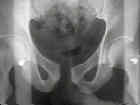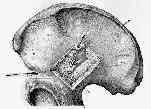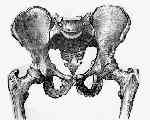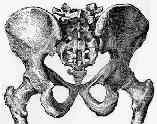- Discussion:
- anterior injury may be through symphysis or thru pubic rami unilaterally or bilaterally;
- symphysis disruption may also occur with pubic rami fractures;

- posterior injury: degree of SI joint disruption depends on the energy sustained during the trauma;
- sacrotuberous and sacrospinous ligaments may be disrupted;
- when posterior SI ligaments are disrupted the open book injury is considered unstable;
- Classification of AP Pelvic Fractures:
- diastasis > 1 cm represents pubic instability;
- however, in female patients that have had children, this may be a normal width;
- diastasis of > 2.5 cm represents ligamentous damage at SI joint;
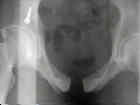
- references:
- Does 2.5 cm of symphyseal widening differentiate anteroposterior compression I from anteroposterior compression II pelvic ring injuries?
- Stress radiograph to detect true extent of symphyseal disruption in presumed anteroposterior compression type I pelvic injuries.
- impotence:
- occurs in 37 % of diastasis patients as result of injury of nervi erigentes or interruption of
the penile blood supply;
- bladder or urethra injury:
- may occur in 50% pts w/ a straddle frx;
- posterior injury:
- posterior lesion may be frx of ilium, sacral frx, or SI dislocation, usually w/ portion of ilium
remaining attached to main sacral frag;
- do not confuse an "isolated pubic ramus frx" w/ LC-I injury pattern;
- Work Up: Physical Exam and Radiographs (reduction of pelvic volume)
- Non Operative Treatment:
- generally pubic rami fractures do not require surgical treatment;
- should be considered for anterior diastasis of less than 2.5 cm;
- example:
- this patient sustained a 2.3 cm diastasis following a parachute injury;
- one week after injury the diastasis closed down to 1.6 cm and did well with non operative treatment;
- Indications for Plating:
- open book fracture, more than 2.5 cm;
- ORIF may also be indicated when there has been concomitant genitourinary injuries;
- ref: Internal Fixation in Pelvic Fractures and Primary Repairs of Associated Genitourinary Disruptions: A Team Approach.
- avoid operating on patients who have previously been operated on for abdominal or urologic injuries;
- fascial planes may be disrupted placing the bladder and other visceral structures at risk
during symphsis pubis repair;
- in these cases consider external fixation; 
- PreOp Planning:
- need to determine the amount of posterior instability;
- ref: Posterior Fixation of APC-2 Injuries Decreases Rates of Anterior Plate Failure and Malunion
- vertical shear injury
- these frx are unstable and while acceptable reduction of posterior displacement may be
obtained by anterior plating, recurrent displacement posteriorly typically occurs;
- posterior or verticle displacement may occur despite application of traction or an external fixator;
- some authors recommend double plating inorder to provide additional stability;
- hence posterior stabilization is required following anterior plating;
- concomitnat repair of pelvic frx and GU injuries:
- pt is positioned supine on a flouro table;
- ref: Internal Fixation in Pelvic Fractures and Primary Repairs of Associated Genitourinary Disruptions: A Team Approach
- Anterior Fixation Methods:
- anterior fixation alone is indicated for type II fractures, where as type III require anterior fixation
along with posterior fixation;
- ref: Current Trends in the Surgical Treatment of Open-Book Pelvic Ring Injuries: An International Survey Among Experienced Trauma Surgeons.
- treatment options:
- Orthomed pelvic reduction clamps (temporary for reduction of pelvic volume)
- External Fixation:
- indicated for SI diastasis or pubic ramus frx which cannot be treated by open reduction
or screw fixation;
- such as may occur w/ suprapubic cystostomy tube or open frx;
- Open Reduction and Plate Fixation:
- types of anterior plates:
- indicated for pubic diastasis greater than 2.5 cm;
- Retrograde Medullary Superior Ramus Screw:
- indicated for superior ramus fractures which occur along w/ an ustable posterior injury
Pelvic ring disruptions with symphysis pubis diastasis. Indications, technique, and limitations of anterior internal fixation.
Stress fractures of the pubic ramus. A report of twelve cases.
The Symphysis Pubis: Anatomic and Pathologic Considerations.
Impotence after fractures of the pelvis.
Internal fixation of symphyseal disruption resulting from childbirth
Open reduction and internal fixation of a traumatic diastasis of the pubic symphysis: one-year radiological and functional outcomes
Management outcomes in pubic diastasis: our experience with 19 patients.


